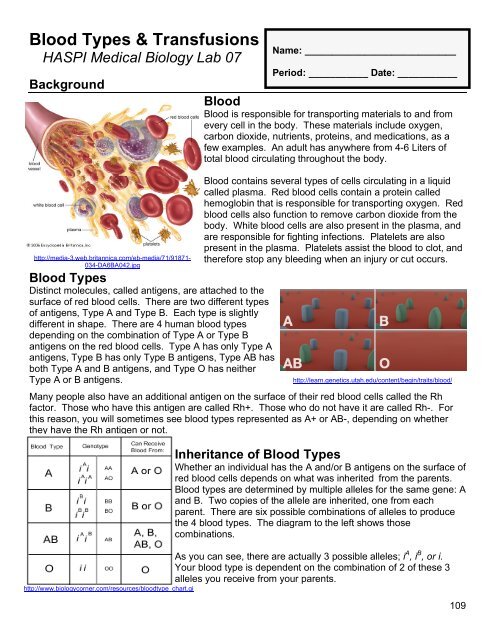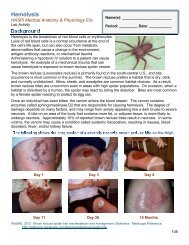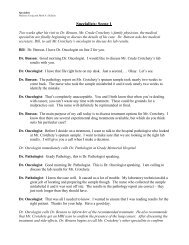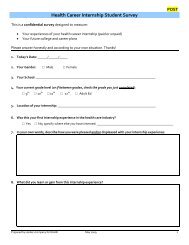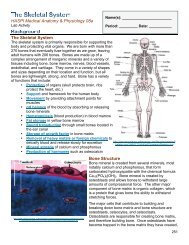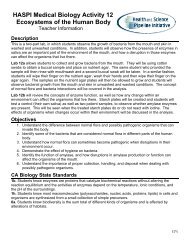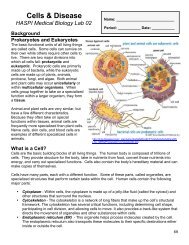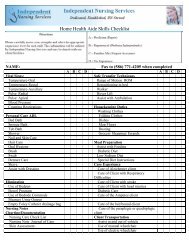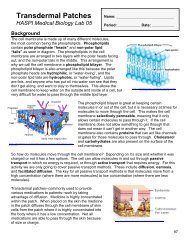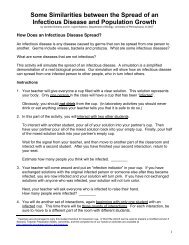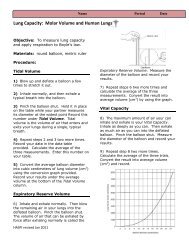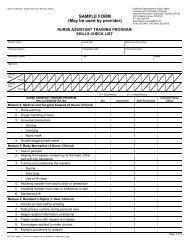07 Blood Types & Transfusions - Student.pdf - haspi
07 Blood Types & Transfusions - Student.pdf - haspi
07 Blood Types & Transfusions - Student.pdf - haspi
Create successful ePaper yourself
Turn your PDF publications into a flip-book with our unique Google optimized e-Paper software.
September 16, 2013Page 3(Revisions to FHA’s Loss Mitigation Home Retention Options) in order to eliminate the requirementthat borrowers must be “currently employed” in order to qualify for loan modifications. The Senatorssaid that there is “no good justification” for those whose income comes from somewhere other thanemployment, such as seniors receiving Social Security benefits. In a statement, the FHA said that theagency is “well aware that there was confusion regarding the treatment of income sources forborrowers seeking loss mitigation” and will issue a new letter to allow borrowers with other sources ofincome to qualify.House of RepresentativesHouse Passes Bill to Move to Multistate Licenses for Insurance Agents and BrokersOn September 10 th , the House passed the National Association of Registered Agents and BrokersReform Act (H.R. 1155) in a vote of 397 to 6. The bill would establish a national licensing system forstate-regulated insurance agents and brokers. The House has approved similar legislation in the pasttwo Congresses and the Senate Banking Committee passed its version earlier in the year. (S. 534).TheIndependent Insurance Agents & Brokers of America and the Council of Insurance Agents & Brokersboth praised the House for advancing the bill which would allow them to operate in multiple stateswith a single license.Cordray Appears Before House Financial Services CommitteeOn September 12 th , the House Financial Services Committee met to consider testimony from Directorof the CFPB Richard Cordray in the Bureau’s semi-annual report to Congress. It was the first time thatCordray had appeared before Chairman Hensarling’s committee, but it didn’t stop both Democraticand Republican lawmakers from asking him some tough questions. As would be expected thequestions primarily focused on the new QM rule and the effect the mortgage reforms will have on smallcommunity banks. For example, Representative Capito (R-WV) and other Republicans on theCommittee suggested implementation of the QM rule should be delayed for at least one year (thePATH Act would delay implementation) so that community banks can come into compliance. Inresponse to these concerns, Director Cordray highlighted the safe harbor and portfolio lendingprovisions that will help community banks with under $2 billion in assets. In addition, panelRepublicans were heavily focused on the Bureau’s data collection efforts and drew parallels to therecent scandals with the National Security Agency (NSA) and the IRS. Mr. Cordray didn’t agree withthese analogies and attempted to explain that the CFPB has three separate collection categories:consumer complaints, institutional enforcement, and market monitoring.House Financial Services Subcommittee Probes HUD SpendingOn September 10 th , the House Financial Services Subcommittee on Oversight and Investigationsquestioned the Department of Housing and Urban Development (HUD) Inspector General DavidMontoya on waste, fraud, and abuse at the agency. The Subcommittee examined the most recent IGreport from HUD, which found more than $770 million in disputed costs and identified $739.5 millionHUD funds which could have been put to better use. Chairman of the Subcommittee Patrick McHenry(R-NC) identified the agency’s Community Development Block Program (CDBG), which includesdisaster relief programs, as a particularly troubling source of fraud, waste, and lack of oversight.McHenry said that, although CDBG funds are intended for low- and moderate-income persons,“CDBG funds often end up being used for parks, pools, street signs, and community centers, divertingdollars from those communities with the greatest need, particularly housing.”House Financial Services Committee Examines the Fed on the Centennial of its Foundingwww.mlstrategies.com
Name: _______________________________________ Date: ____________ Period: ___________7. If well A shows agglutination put a + in the Anti-A Reaction column. If it does not showagglutination put a – in the Anti-A Reaction column.8. If well B shows agglutination put a + in the Anti-B Reaction column. If it does not showagglutination put a – in the Anti-B Reaction column.9. Rinse off and dry the well tray. Repeat steps 2-8 for all of the patient blood samples and thetransfusion bag samples.AnalysisData Table 1Patient Name/IDMr. Stone/ 55991Mrs. Patrick/ 11180Mr. Ascot/ 22568Mr. Thompson/ 44875Ms. Richards/ 66123Ms. Johnson/ 33009Data Table 2Transfusion BagBag 1Bag 2Bag 3Bag 4Bag 5Bag 6Anti-AReactionAnti-AReactionAnti-BReactionAnti-BReaction<strong>Blood</strong> Type<strong>Blood</strong> TypeAnalysis Questions - on a separate sheet of paper complete the following1. Create a combined data table that summarizes the original patient and transfusion bloodtypes from the Patient Medical Information, and the blood types you obtained from yourtesting in Data Table 1 and Data Table 2.2. For each of the patients, summarize the purpose of the surgical procedure performed asindicated in the Patient Medical Information.3. Did any of the patients who received Type O have any problems? Explain why someonewho received Type O in surgery might have a problem with agglutination.4. Explain on a cellular level why giving someone Type B if he or she is Type A would be aproblem.5. Why did this day have an abnormally high mortality rate?6. Do you think this is a case of negligence or malpractice?7. CONCLUSION: In 1-2 paragraphs summarize the procedure and results of this lab.Adapted from Using <strong>Blood</strong>-Typing to Determine Causes of Death in Surgery Patients, PACT 2000 112
Name: _______________________________________ Date: ____________ Period: ___________Review Questions - on a separate sheet of paper complete the following1. List 3 materials that blood is responsible for transporting through the body.2. How much blood does an adult have circulating the body?3. What is the function of red blood cells, white blood cells, and platelets?4. What is the difference in antigens between Type A, Type B, Type AB, and Type O bloodtypes? (you may draw a picture to illustrate the difference)5. What is the difference between Type A+ and Type A-?6. What genotype(s) could a person with Type AB blood have? What about Type B?7. What are antibodies, and how do they interact with antigens?8. Why is it important to match the blood types of donors and patients during bloodtransfusions?9. Why are Type O and Type AB “special” when it comes to blood transfusions? Use theterms antigen and antibody in your explanation.10. Could a person with Type B blood safely receive Type A blood? Explain.11. Could a person with Type A blood safely receive Type O blood? Explain.12. Why is it important to have a blood transfusion of the exact type match?13. Could a man with Type O be the father of a Type AB child? Explain.14. Could a Type B child with a Type A mother have a Type A father? Explain.15. Look at Diagram A below. What continent has the lowest percentage of the A allele?The highest percentage? How and why could this have occurred?16. Correctly complete the table below.<strong>Blood</strong>GroupAntigens onred blood cellsAntibodies inplasmaCan receiveblood fromCan giveblood toA A A and ABBAnti-AAB A and BOODiagram Ahttp://s155239215.onlinehome.us/turkic/63_<strong>Blood</strong>_<strong>Types</strong>/<strong>Blood</strong>_<strong>Types</strong>En_files/image003.gifAdapted from Using <strong>Blood</strong>-Typing to Determine Causes of Death in Surgery Patients, PACT 2000 113
Name: _______________________________________ Date: ____________ Period: ___________Going Further1. Use the data table below to examine the number of individuals having the following blood types.Use this data to complete the incomplete table, which follows:<strong>Blood</strong> Type O A B AB Rh+ Rh-% of people having theblood type 45 40 12 3 85 152. Complete the data table below using the data previously provided.<strong>Blood</strong>TypeO +O -A +A -B +B -AB +AB -% of NonRh <strong>Blood</strong>Type% Rh+ orRh-MultipliedTogether<strong>Blood</strong> Type%(divide by 100)3. Use the data you computed for the 8 blood types above to construct a bar graph. Determine anappropriate scale and label the graph.Adapted from Using <strong>Blood</strong>-Typing to Determine Causes of Death in Surgery Patients, PACT 2000 114


